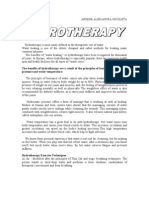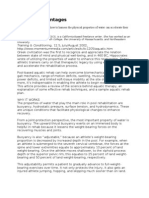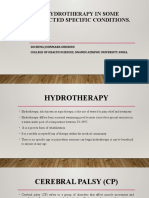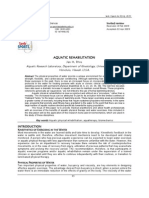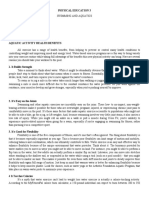Swimming Benefits
Swimming Benefits
Uploaded by
ankithdukkuCopyright:
Available Formats
Swimming Benefits
Swimming Benefits
Uploaded by
ankithdukkuCopyright
Available Formats
Share this document
Did you find this document useful?
Is this content inappropriate?
Copyright:
Available Formats
Swimming Benefits
Swimming Benefits
Uploaded by
ankithdukkuCopyright:
Available Formats
Photo: R.
RaguIncredible progress: Exercise
is easier in water.
Aquatherapy or exercising in water helps a variety of people with their health problems, says well known sports medicine consultant Dr. Kannan Pugazhendi.
There are many facets to his healing: his touch, his therapy... I explore the avenues, one at a time. One extremely successful arm of treatment is aquatherapy, which has been the backbone of the Pugazhendi stay healthy regime. The indoor pool is warm, sparkling and inviting. It is a women only morning. Women arrive with walkers, canes and crutches. Some limp along holding a friend, terrified of falling on the water-drenched floor outside the pool. They are helped into the pool. Those who find it a terrifying experience are encouraged to hold the supports by the side and walk slowly till they gain confidence. Priya, the physiotherapist, stands at the edge of the pool guiding her patients. She teaches them how to walk, to march, do various kick exercises and squats. I revisit the scene after four weeks. The progress is incredibly encouraging. Most of the women are able to walk on their own and the ones who cannot have made at least 30 per cent progress. As an eminent sports medicine doctor who treats injuries and restores normality of movement in patients as well as establishing maximum mobility, what made him turn to water? Recovery without pain It began with training R. Natarajan, a national-level sprinter diagnosed with two stress fractures on his shin bone as he was preparing for the selection trials for the Asian Games in 1994. Dr.Kannan Pugazhendi designed the mode of training and the exercises to be done in water to maintain flexibility, muscle tone and explosive strength without causing pain. High knee action and stretches in water resulted in a speedy recovery without any pain. I broke my own national record at the Asian Games in the 100m and 200m, says Natarajan.
Recently diagnosed with a tear in his right Achilles tendon, Natarajan sought Pugazhendi's guidance, though various specialists had said surgery was the only way out. Three weeks of aquatherapy, which consisted of walking in water and ankle and toe movements completed the healing process without the ordeal of surgery. Who are the patients ideal for aqua therapy? Almost everyone. Dr. Kannan has treated patients with acute knee pain, those who cannot afford surgery, those suffering from osteo-arthritis, osteoporosis, rheumatoid arthritis Bharatanatyam dancers... Of course, there are some whom aqua therapy will not suit. Cardiac patients need to get an all-clear from their cardiologists. The coolness of the water (even in a place like Chennai) chills the body and the heart has to pump harder to even out the circulation. The heart should not go into shock at this effort. A person not used to swimming or water is advised to start aqua therapy for five minutes and increase it slowly to one-hour sessions. At least initially all exercises need to be done under medical supervision or by trained physiotherapists. Actor Anushka swears by aquatherapy, which she claims got rid of her knee pain in a few weeks time while strengthening her muscles without straining her knee. Dancer Surupa Sen describes that Dr. Kannan motivated her recovery from back pain and knee pain which many dancers suffer from. Aqua therapy enabled a greater range of exercise and movement, which sustained my fitness over a longer period of time. That was by far the most beneficial treatment to help me stay flexible and strong throughout the recovery period, she says. The body weight is reduced by 90 per cent in water and the buoyancy makes even the more difficult exercises doable. For instance persons with knee problems are generally advised not to squat. In water, one can do all this and more without discomfort or injury. Even jogging is permissible. The exercises are very specific to each person and each person needs to work out under an exercise prescription. You don't need to know swimming to undergo aquatherapy. Enjoyable experience Watching persons in the thick of it, I am convinced the experience is very enjoyable. The initial problem was getting the women to shed their inhibitions and get into water, says Dr. Kannan. The reluctance stemmed from having to wear a swimsuit. The resourceful doctor got permission from the authorities concerned to allow the women to wear clean salwar-kameez or tights and half the battle was won. The ideal candidates for aqua therapy are the geriatric population. Those with ataxia (which causes loss of balance) find their limbs are strengthened and they are steadier on their feet during normal walking. Those with respiratory problems are greatly benefitted as compressed water exits exhalation. Muscle tone is improved for those with hypertrophy. It is indeed a mega treatment even for those who have undergone bypass surgery, with the consent of the cardiologist, of course. The exercises seem gentle and easy, but the after effect is mind boggling. You begin with a warm up, as in any exercise regime, then begin exercises. Half an hour of aquatherapy is equal to an hour of walking or workouts in the gym. According to Pugazhendi, after the initial healing takes place in the case of a limb fracture, aqua therapy restores, maintains function, and enhances mobility. Of course where nothing else works, surgery is the ultimate answer, in certain cases, and I don't rule this out entirely, he says. Any new developments in aqua therapy? I am constantly devising new methods, which might prove to be beneficial, says Dr Pugazhendi. I am trying out yoga and pilates in water, which will improve the entire musculo-skeletal system. This will help to strengthen bone mass. Kalari in water is the next experiment, and pranayama in water should be really beneficial in assisting the mental and physical progress of the individual.
If this, as the good doctor says, improves the quality of life, swimming pools should be easily accessible to the populace. And if pools can be reserved for women, the response will be greater, most Indian women cannot come to terms about sharing a pool with men. Though it is wishful thinking, an indoor pool will attract more women, as the fear of getting exposed to sun is dormant in them! Any non-formal method of healing, which eliminates the trauma of surgery, will always be welcome to patients and fitness freaks to whom wellness is a big factor in good living. Benefits Due to the water buoyancy, exercises are easier It is almost a return to the womb' feeling, and a snugness and confidence once patients get used to the water You carry only 10 per cent of the body weight, so doing exercises is much easier There is uniform omnipotent pressure in the water, and the weight bearing joints are faced with minimum load The muscle mass is improved and, with regular workouts, the gait is improved The writer is a Chennai-based freelance writer and author. Email her at kittsasbi@dataone.in
You might also like
- Kolkata Paces Final-1Document17 pagesKolkata Paces Final-1Dr. Tom100% (1)
- GSAQDocument1 pageGSAQUtia KhairaNo ratings yet
- Aqua Progressions Manual 2020 OnlineDocument40 pagesAqua Progressions Manual 2020 OnlineDoris Coria SarabiaNo ratings yet
- Post Activity Report On MBDDocument2 pagesPost Activity Report On MBDRoselle LimNo ratings yet
- Aktiviti Latihan Terapi AirDocument2 pagesAktiviti Latihan Terapi Airas-suhairiNo ratings yet
- Guidelines For Giving Enema: HydrotherapyDocument3 pagesGuidelines For Giving Enema: HydrotherapyDeboo X XavierNo ratings yet
- Aquaticexercises 141130033308 Conversion Gate02Document36 pagesAquaticexercises 141130033308 Conversion Gate02Dolly Joy Bautista AsuncionNo ratings yet
- The Benefits of Hydrotherapy Are A Result of The Principles of Buoyancy, Hydrostatic Pressure and Water TemperatureDocument5 pagesThe Benefits of Hydrotherapy Are A Result of The Principles of Buoyancy, Hydrostatic Pressure and Water TemperatureAlexandra ArseneNo ratings yet
- Water Therapy Exercise ProgramDocument4 pagesWater Therapy Exercise Programrenee_soong127100% (1)
- Make the Pool Your Gym: No-Impact Water Workouts for Getting Fit, Building Strength and Rehabbing from InjuryFrom EverandMake the Pool Your Gym: No-Impact Water Workouts for Getting Fit, Building Strength and Rehabbing from InjuryRating: 5 out of 5 stars5/5 (1)
- Make the Pool Your Gym, 2nd Edition: No-Impact Water Workouts for Getting Fit, Building Strength and Rehabbing from InjuryFrom EverandMake the Pool Your Gym, 2nd Edition: No-Impact Water Workouts for Getting Fit, Building Strength and Rehabbing from InjuryNo ratings yet
- Exercise and SclerodermaDocument22 pagesExercise and SclerodermaLupin TohNo ratings yet
- Water TherapyDocument30 pagesWater Therapyhimamat100% (1)
- SwimmingDocument4 pagesSwimmingNeighvestNo ratings yet
- Aquatic ExercisesDocument36 pagesAquatic ExercisesgialinuNo ratings yet
- Hydrotherapy by Abdul Ghafoor Sajjad Physiotherapist AFIRMDocument4 pagesHydrotherapy by Abdul Ghafoor Sajjad Physiotherapist AFIRMAbdul Ghafoor SajjadNo ratings yet
- 2254 HydrotherapyDocument16 pages2254 HydrotherapyFiona CheeNo ratings yet
- HydrotherapyDocument14 pagesHydrotherapyKumaravel MuruganNo ratings yet
- Therapeutic Swimming: Teacher: Anca Pop and Sturzu Bogdan Student:Benea Adrian DanielDocument10 pagesTherapeutic Swimming: Teacher: Anca Pop and Sturzu Bogdan Student:Benea Adrian DanielRubenNo ratings yet
- Benefits of SwimmingDocument3 pagesBenefits of SwimmingMildred VillarubiaNo ratings yet
- Aquatic TherapyDocument37 pagesAquatic TherapyMustafa Mabrouk100% (1)
- What Is Aquatic TherapyDocument5 pagesWhat Is Aquatic TherapyHaslindaNo ratings yet
- Activity 2Document6 pagesActivity 2Christine Joy LealNo ratings yet
- Incontinence a Time to Heal with Yoga and Acupressure: A Six Week Exercise Program for People with Simple Stress Urinary IncontinenceFrom EverandIncontinence a Time to Heal with Yoga and Acupressure: A Six Week Exercise Program for People with Simple Stress Urinary IncontinenceNo ratings yet
- Effects of A 12-Week Aerobic Exercise On Back Spine and Thigh Bone Mineral Density in Heavy Women After MenopauseDocument8 pagesEffects of A 12-Week Aerobic Exercise On Back Spine and Thigh Bone Mineral Density in Heavy Women After Menopausemona indahNo ratings yet
- Article 3Document3 pagesArticle 3somyaNo ratings yet
- Aquatic Therapy Services in Women HealthDocument21 pagesAquatic Therapy Services in Women HealthMohammad Ajmal Madni100% (1)
- Obesity Awareness - 18 October 2020Document6 pagesObesity Awareness - 18 October 2020Times MediaNo ratings yet
- Dr. Ketas MAhajan PDFDocument21 pagesDr. Ketas MAhajan PDFDr. Ketas MahajanNo ratings yet
- GMC PE Basic SwimmingDocument22 pagesGMC PE Basic SwimmingDaisy hermilao NecesarioNo ratings yet
- Seminar On Various Child Birth Practice, PositionDocument26 pagesSeminar On Various Child Birth Practice, PositionPiyush Dutta100% (2)
- 15 Benefits of Swimming: 1. A Whole-Body WorkoutDocument3 pages15 Benefits of Swimming: 1. A Whole-Body WorkoutdonylllNo ratings yet
- Impact of Aquatic InterventionsDocument28 pagesImpact of Aquatic InterventionsKhaled Hussein YoussefNo ratings yet
- Benefits of SwimmingDocument14 pagesBenefits of SwimmingChiaralyn G. OndiongNo ratings yet
- Aquatics: Prepared By: Allan D. ArlosDocument21 pagesAquatics: Prepared By: Allan D. ArlosMarc Ian Dela PeñaNo ratings yet
- Aquatic Therapy: Exercising in WaterDocument2 pagesAquatic Therapy: Exercising in WaterdivermedicNo ratings yet
- Aquatic AdvantagesDocument7 pagesAquatic AdvantagesGhita Marius GeorgeNo ratings yet
- Water Aerobics Is A Type of Aerobic ExerciseDocument12 pagesWater Aerobics Is A Type of Aerobic ExercisePete MagaleNo ratings yet
- Water Aerobics: Areas It TargetsDocument3 pagesWater Aerobics: Areas It Targetsedward mirandilla miranda jr.No ratings yet
- Swimming For Recreation: Healthy Weight Heart LungsDocument2 pagesSwimming For Recreation: Healthy Weight Heart LungsJoycs PintoNo ratings yet
- Aquatic Physical Therapy: Thomas Cesarz and David SpeachDocument2 pagesAquatic Physical Therapy: Thomas Cesarz and David SpeachMaria P12No ratings yet
- Hydrotherapy in Some Physiotherapy CasesDocument27 pagesHydrotherapy in Some Physiotherapy CasesSochima Johnmark ObiekweNo ratings yet
- Musculoskeletal Wps OfficeDocument27 pagesMusculoskeletal Wps OfficeSteffanie TalaueNo ratings yet
- Aquatic RehabilitationDocument8 pagesAquatic RehabilitationFlorentina MocanuNo ratings yet
- What Is Aquatic Fitness (PDF) (PDF) - 201406250803534554Document6 pagesWhat Is Aquatic Fitness (PDF) (PDF) - 201406250803534554Robin TandalaNo ratings yet
- 362849876 Physical Education ProjectDocument36 pages362849876 Physical Education Projecthackeranimous45No ratings yet
- Exercises for Those Who Suffer a Disk HerniaFrom EverandExercises for Those Who Suffer a Disk HerniaRating: 5 out of 5 stars5/5 (2)
- Unit III Yoga As Preventive Measure For Lifestyle DiseaseDocument47 pagesUnit III Yoga As Preventive Measure For Lifestyle DiseaseAditya MISHRANo ratings yet
- Ultimate Rehabilitation For DogsDocument124 pagesUltimate Rehabilitation For Dogsclarice.rogueNo ratings yet
- PEH 4 AQUATICSsDocument7 pagesPEH 4 AQUATICSsCharmaine PearlNo ratings yet
- Yoga Therapy For Simple Back PainDocument7 pagesYoga Therapy For Simple Back Painpartheeban25No ratings yet
- Aging Backwards: Fast Track: 6 Ways in 30 Days to Look and Feel YoungerFrom EverandAging Backwards: Fast Track: 6 Ways in 30 Days to Look and Feel YoungerNo ratings yet
- Water Aerobics: The Ultimate Guide on How to Lose Weight Fast, Increase Flexibility, tone the body and Correct Bad Posture in the WaterFrom EverandWater Aerobics: The Ultimate Guide on How to Lose Weight Fast, Increase Flexibility, tone the body and Correct Bad Posture in the WaterRating: 3 out of 5 stars3/5 (1)
- CH 3 Yoga As Preventive Measure For Lifestyle DiseaseG 12-1Document73 pagesCH 3 Yoga As Preventive Measure For Lifestyle DiseaseG 12-1jadenjewels13No ratings yet
- Sana Alllll Daw Eh NoDocument2 pagesSana Alllll Daw Eh NoJon JoeruNo ratings yet
- P.E Lesson 2Document4 pagesP.E Lesson 2Aby MauanayNo ratings yet
- Benefits of SnorkelingDocument2 pagesBenefits of SnorkelingApple RoncalNo ratings yet
- Posterior Cruciate Ligament Reconstruction: Orthopaedic Surgery, Sports Medicine and RehabilitationDocument3 pagesPosterior Cruciate Ligament Reconstruction: Orthopaedic Surgery, Sports Medicine and RehabilitationUmaSankar mohanNo ratings yet
- Kevin Clark NCTMB: Back Pain and MassageDocument4 pagesKevin Clark NCTMB: Back Pain and MassageKevin ClarkNo ratings yet
- Spinal Fusion Surgery IndiaDocument9 pagesSpinal Fusion Surgery Indiainfo3675No ratings yet
- ContradictionDocument2 pagesContradictionShahil SinghNo ratings yet
- Dr. Jyoti Gangwal 2020Document7 pagesDr. Jyoti Gangwal 2020Support CocNo ratings yet
- Risk Management in Food IndustryDocument17 pagesRisk Management in Food IndustryShyanyoon Teh100% (2)
- Sex-Based Differences in Physiology: What Should We Teach in The Medical Curriculum?Document3 pagesSex-Based Differences in Physiology: What Should We Teach in The Medical Curriculum?Khaled Abdel-saterNo ratings yet
- Nursing Leadership & Management: Patricia Kelly-Heidenthal 0-7668-2508-6Document20 pagesNursing Leadership & Management: Patricia Kelly-Heidenthal 0-7668-2508-6gopscharanNo ratings yet
- WhataretheargumentsforandagainstvaccinationsforchildrenDocument11 pagesWhataretheargumentsforandagainstvaccinationsforchildrenapi-220893802100% (1)
- Assignment 2 Evidence Summary Instructions and Rubric-2Document9 pagesAssignment 2 Evidence Summary Instructions and Rubric-2shulusha khadkaNo ratings yet
- A Case Presentation of Diabetes Mellitus Type 2 Uncontrolled Non-Healing WoundDocument66 pagesA Case Presentation of Diabetes Mellitus Type 2 Uncontrolled Non-Healing Woundashamy acolNo ratings yet
- Human Papilloma Virus Vaccine For Cervical Cancer PreventionDocument9 pagesHuman Papilloma Virus Vaccine For Cervical Cancer Preventionsayeef khanNo ratings yet
- Drug Study - LoperamideDocument3 pagesDrug Study - LoperamideCarissa Mae Tapec EstradaNo ratings yet
- PHS 812 Global HealthDocument182 pagesPHS 812 Global Healthirene oget otienoNo ratings yet
- ALPCO's Quality Management System Receives ISO 13485:2016 CertificationDocument2 pagesALPCO's Quality Management System Receives ISO 13485:2016 CertificationPR.comNo ratings yet
- Sample Bid BulletinDocument6 pagesSample Bid BulletinNehru Valdenarro ValeraNo ratings yet
- Effect of The Neuromuscular Taping (NMT) Towards Flexibility Muscle Functions at The Lower Back and HamstringsDocument3 pagesEffect of The Neuromuscular Taping (NMT) Towards Flexibility Muscle Functions at The Lower Back and HamstringsInternational Journal of Innovative Science and Research TechnologyNo ratings yet
- ArehighpotencyactivepharmaceuticalingredientsHPAPIalsohighrisksforcross Contamination Final PDFDocument4 pagesArehighpotencyactivepharmaceuticalingredientsHPAPIalsohighrisksforcross Contamination Final PDFnataarajan praveenNo ratings yet
- ReferencesDocument3 pagesReferencesapi-404686663No ratings yet
- High Power CommitteeDocument39 pagesHigh Power CommitteeJaya PrabhaNo ratings yet
- Risk Assessment and Management in Chemical Industry in Vietnam - SINHDocument24 pagesRisk Assessment and Management in Chemical Industry in Vietnam - SINHMinh Hoàng Nguyễn HữuNo ratings yet
- JLM23 Medical CareDocument29 pagesJLM23 Medical CarePeggy PlewsNo ratings yet
- Management of Infectious DiseaseDocument17 pagesManagement of Infectious DiseaseLeni CarununganNo ratings yet
- Annotated BibliographyDocument13 pagesAnnotated BibliographyNikhil LandeNo ratings yet
- Tetanus - CDCDocument23 pagesTetanus - CDCPradita Sri MitasariNo ratings yet
- TFN Notes Lesson 1Document3 pagesTFN Notes Lesson 1Cristina GreyNo ratings yet
- Personal StatementDocument2 pagesPersonal StatementAria WexlerNo ratings yet
- GIS, Remote Sensing - Applications in The Health SciencesDocument231 pagesGIS, Remote Sensing - Applications in The Health ScienceslynxnetNo ratings yet
- Rational Clinical Examination - Evidence-Based Clinical DiagnosisDocument11 pagesRational Clinical Examination - Evidence-Based Clinical DiagnosisDanteNo ratings yet
- Jurnal Saraf 1Document7 pagesJurnal Saraf 1Rifqi arinaNo ratings yet
- OccupationDocument15 pagesOccupationapi-300148801No ratings yet
- AppendicitisDocument7 pagesAppendicitisTim LuoNo ratings yet







